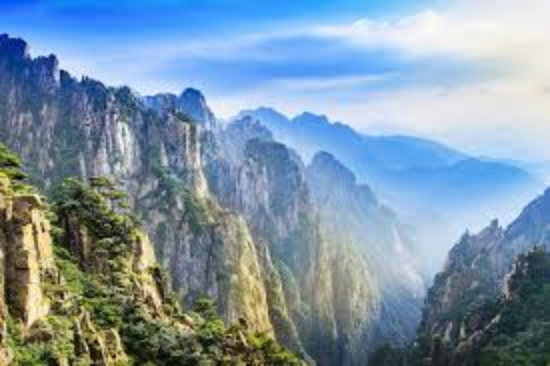
What Natural Wonders Can You Behold in Huangshan?
Huangshan, literally meaning "Yellow Mountain", is a mountain range in southern Anhui province in eastern China. The area is renowned for its breathtaking scenery, often depicted in traditional Chinese paintings and literature, and increasingly captured in modern photography. But what exactly makes Huangshan such a captivating destination for nature enthusiasts? Let's delve into the natural wonders that await you in this magical place.
1. A Feast for the Eyes: Scenic Splendors
Huangshan is home to an array of stunning landscapes that shift and transform with the changing seasons.
- Peculiarly-shaped granite peaks: Imagine towering granite peaks piercing the sky, their weathered surfaces sculpted by millennia of wind and rain. These peaks, with names like "Lotus Peak" and "Bright Summit Peak", are not merely geological formations but natural sculptures that spark the imagination.
- Table: Some famous peaks and their elevations | Peak Name | Elevation (meters) | |---|---| | Lotus Peak | 1864 | | Bright Summit Peak | 1840 | | Celestial Capital Peak | 1829 |
- Wondrous rock formations: Beyond the peaks, you'll encounter a wonderland of bizarre and beautiful rock formations. Some resemble animals frozen in mid-stride, others seem to defy gravity, and all inspire a sense of awe at the power of nature.
- Cascading waterfalls: Adding to the visual symphony are numerous waterfalls, their white ribbons cascading down the mountain sides, especially captivating after rainfall.
2. Painting the Sky: Spectacular Sunsets
As the day draws to a close, prepare to be mesmerized by the breathtaking sunsets in Huangshan.
- A canvas of color: The sky transforms into a canvas of vibrant hues, with oranges, reds, purples, and pinks blending seamlessly. The setting sun casts long, dramatic shadows across the peaks, creating a truly unforgettable spectacle.
- Ideal viewpoints: Many hotels and dedicated viewing platforms are strategically located to offer the best vantage points for this daily spectacle.
3. A Sea of Clouds: The Cloud Phenomenon
Huangshan is famous for its frequent cloud formations, which create a surreal and ever-changing landscape.
- Above the clouds: Imagine yourself standing above a sea of fluffy white clouds, the peaks emerging like islands in a celestial ocean. This ethereal phenomenon, known as "cloud sea", is a sight that will stay with you long after you leave Huangshan.
- Sunrise and sunset magic: The cloud sea is particularly enchanting at sunrise and sunset, when the sunlight paints the clouds in breathtaking shades of gold and crimson.
4. The Sentinels of the Mountain: Huangshan Pine Trees
No description of Huangshan's natural wonders would be complete without mentioning the iconic Huangshan pine trees (Pinus hwangshanensis).
- Unique beauty: These hardy trees, clinging tenaciously to the cliffs and slopes, are known for their unique and picturesque shapes. Twisted trunks, windswept branches, and vibrant green needles give them an almost mythical quality.
- Symbolism: The Huangshan pine is a symbol of resilience and strength, a testament to nature's ability to thrive in even the harshest environments.
5. Geothermal Gifts: Natural Hot Springs
After a day of exploring the mountain trails, reward yourself with a rejuvenating soak in one of Huangshan's natural hot springs.
- Therapeutic benefits: Rich in minerals, these springs are believed to have therapeutic properties, soothing aching muscles and revitalizing the body.
- Scenic locations: Many hot springs are situated in picturesque locations, allowing you to unwind amidst stunning natural beauty.
6. Winter Wonderland: A Blanket of Snow
While Huangshan is stunning year-round, winter transforms the landscape into a magical wonderland.
- Snow-dusted landscapes: Imagine the granite peaks capped with snow, the pine trees transformed into frosted sculptures, and the waterfalls frozen in time. The air is crisp and clean, and the silence is broken only by the crunch of snow underfoot.
- Unique photographic opportunities: Winter in Huangshan provides photographers with unique opportunities to capture the ethereal beauty of this mountain range.
Q&A
Q1: What is the best time of year to visit Huangshan?
A1: Huangshan is stunning year-round, but the best time to visit depends on your preferences. Spring offers blooming flowers, summer boasts lush greenery, autumn showcases vibrant foliage, and winter transforms the landscape into a snowy paradise.
Q2: How do I get to the top of Huangshan?
A2: You can reach the summit by hiking or by taking a cable car. There are multiple hiking trails with varying difficulty levels, offering breathtaking views along the way.
Q3: What should I pack for a trip to Huangshan?
A3: Be sure to pack comfortable hiking shoes, layered clothing for fluctuating temperatures, sunscreen, rain gear, a hat, sunglasses, and plenty of water.